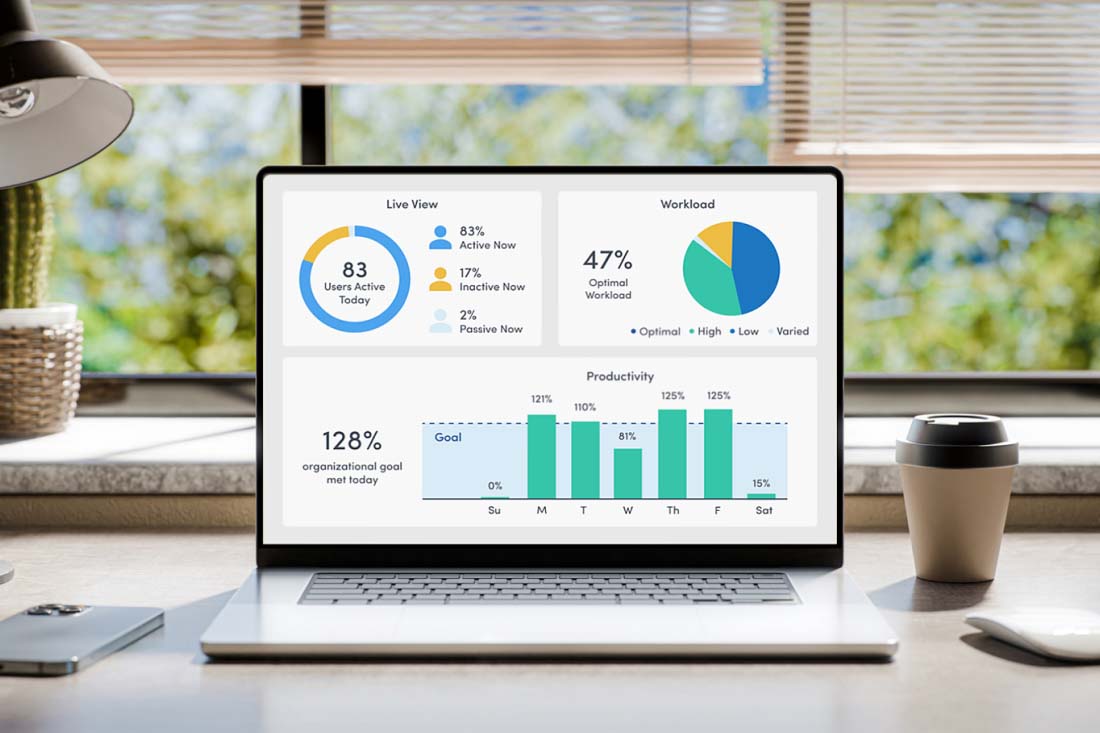Our goal is to help employees all over the world — whether office-based employees, remote workers, or somewhere in between — work wiser. Working wiser looks different for every person and the future of work will reflect this. That’s why we’ve created solutions that will help you maximize productivity regardless of your work environment.
What is a hybrid work model? What are the benefits and challenges of taking a hybrid approach? We’ll explore these questions in this article and share how ActivTrak can support a smooth transition to a hybrid work model.
Defining Hybrid Work: The Different Types
Long before the coronavirus pandemic began, many companies were envisioning and exploring new approaches to office work that weren’t limited to a physical office and allowed more choice and flexibility. As remote work became the default norm during and after the pandemic, some managers and employees discovered that full-time remote work might not be the perfect fit for a long-term workplace strategy. It became clear that different, more flexible work models were needed, ones that maintained the perks associated with remote work while also offering a way to access the perks that come with in-office work.
Hybrid work models let employees get work done in whatever work environment best supports their productivity and business results — at home, in the office, or in a “third place” like a coffee shop or local co-working space.
The four types of hybrid work models are:
- Universal: The hybrid work arrangement or policy is universally applied across the organization, with fixed days in-office or remote. For example, in a universal model, all employees could work on-site on Monday, Wednesday, and Friday and from a remote location on Tuesday and Thursday.
- Variable: The hybrid work arrangement or policy is variably applied across the organization, with decisions made at the team level. For example, the policy could say all employees have to work on-site a minimum of 2 days a week, but not necessarily the same two days. So the Sales team might agree to be on-site Mondays and Thursdays while Finance is on-site Tuesdays and Thursdays.
- Flexible: The hybrid work arrangement or policy is flexibly applied across teams, with decisions made between an individual manager and employee. For example, the Marketing team could be on-site on Mondays for meetings and then team members can select another day to work in-office.
- Fluid: With a fluid model, the arrangement or policy is less formal. This works best for small businesses that want to maintain office space and give employees the option to be in the office, but don’t feel a need to make employees come in at a specific frequency. Employees can choose to be almost entirely remote, or they can choose to come to the office space daily.
The Benefits of Hybrid Work Models
When properly implemented, there are numerous benefits to the hybrid model. That’s why it is emerging as a major operating model for the future of work. These benefits include:
- Collaboration: Employees and teams have access to a wider variety of collaboration tools in a hybrid environment. For some tasks or projects, real-time face-to-face interactions and physical meeting spaces best support productivity. For other tasks and projects, particularly asynchronous, virtual collaboration tools are more efficient.
- Work-life balance: Companies looking to keep their employees happy, engaged, and productive need to remain conscious of work-life balance. With a hybrid work model, employees have more options, and more control over their own schedules to better balance commuting preferences and accommodate childcare needs and personal well-being.
- Social Connection: Some remote employees enjoy working at home full-time, some team members may find themselves struggling with social isolation in a fully remote work environment. Hybrid companies can help combat that by offering regular opportunities for employees to engage with their coworkers in person during their in-office days.
- Access to talent: The advantages of a hybrid work model extend beyond employees. Hybrid companies are more attractive to prospective hires because of the flexibility they offer, which gives recruiters a deeper pool of talent to pull from.
- Resource Allocation: Hybrid companies don’t require nearly as much office space, and that office space can even be in a third-party-managed coworking space. The money saved by switching to a hybrid approach can be put toward employee perks like memberships to fitness clubs, home office allowances, technology, and other resources that will help hybrid employees stay productive.
The Challenges of Hybrid Models
There are bound to be challenges with any new working arrangement, and a hybrid workplace is no different. The two biggest challenges associated with hybrid work concern visibility and culture.
- Visibility into employee activity: It can be difficult to gauge employee productivity, keep track of workload balance, and help employees who might be at risk of burnout. With the help of workforce analytics software, managers can collect data and gain insights that help them understand how their team members work and identify areas for improvement.
- Culture: Hybrid work offers opportunities for team building and face-to-face interaction. Unfortunately, it also presents challenges when it comes to preventing inequity between employees who spend more time working from home and those who spend less. Organizations looking to successfully implement a hybrid model must make sure that they offer robust support and resources to employees, and make every effort to create a healthy and equitable company culture.
How ActivTrak Supports High-Performance Hybrid Work Models
If a hybrid work model is a good fit for your organization, workforce productivity analytics can help you make the transition seamlessly and successfully and support sustained improvements.
The success of your hybrid approach requires a new generation of tools designed to help managers better understand barriers to individual and team performance, create healthy habits that drive better results, and help teams work wiser. The comprehensive data and insights you gain from ActivTrak’s workforce analytics platform deliver on those needs, enabling you to create and maintain a culture where employees feel valued and are empowered to do their best work no matter where they are.
- Workforce and Productivity Management: Get visibility into how daily work gets done and identify areas where improvement can occur with the aid of clear visual dashboards and actionable insights.
- Employee Engagement & Experience: Use insights into workload balances, working hours, focus hours, and more to identify opportunities to redesign workdays and workflows, protect focus time, and prevent burn-out.
- Benchmarks & Goals: Understand how and when work gets done to encourage a culture of continuous improvement. Create realistic benchmarks and productivity goals based on the data and then see how employees are working toward reaching them.
- Technology Usage: Discover how your organization is using technology, via processes, basic habits, and behaviors, so you can determine how to best leverage the technology you have and identify gaps or underutilized tools.
- Personal Skill Development: Use data to help team members develop essential skills that can boost their well-being and their productivity like time management, avoiding distractions, staying focused, and preventing burnout.
Depending on the type of hybrid model your organization embraces, there are dashboards and reports on the ActivTrak platform to support your needs. For example, if your organization adopts a universal hybrid approach, you may find that the Executive Summary and Benchmark & Goals pages are most useful since they can help you observe the organization and team-wide data and trends to identify any variation in productivity metrics correlating with the fixed schedule you have in place. For a flexible or variable hybrid approach, on the other hand, you may want to focus more on the Team Comparison or Personal Insights pages to look for any deviations from typical behaviors or to find ways to encourage employee utilization.
No matter what kind of hybrid work model you adopt, ActivTrak’s workforce productivity analytics platform provides the data you need to make the transition smooth and successful.
Boost Productivity with a Hybrid Model
Hybrid models give organizations and employees the opportunity to access the advantages offered by remote work and by full-time office work, but moving to a hybrid model as the future of work can be a challenge. The ActivTrak team is here to help make the process as simple and straightforward as possible. Our workforce analytics platform gives you the data and insights you need to create and support a hybrid model that works for your organization.
Pro-Tips:
- Create a hybrid work policy and best practices that clearly lay out expectations for employees.
- Concentrate on fostering a company culture that’s supportive of and equitable for all employees.
About ActivTrak
ActivTrak helps companies unlock productivity potential. Our award-winning workforce analytics and productivity management software provides expert insights that empower people, optimize processes, and maximize technology. Additionally, with data sourced from more than 9,500 customers and over 450,000 users, ActivTrak’s Workforce Productivity Lab is a global center for ground-breaking research and expertise that helps companies embrace and embody the future of work.





